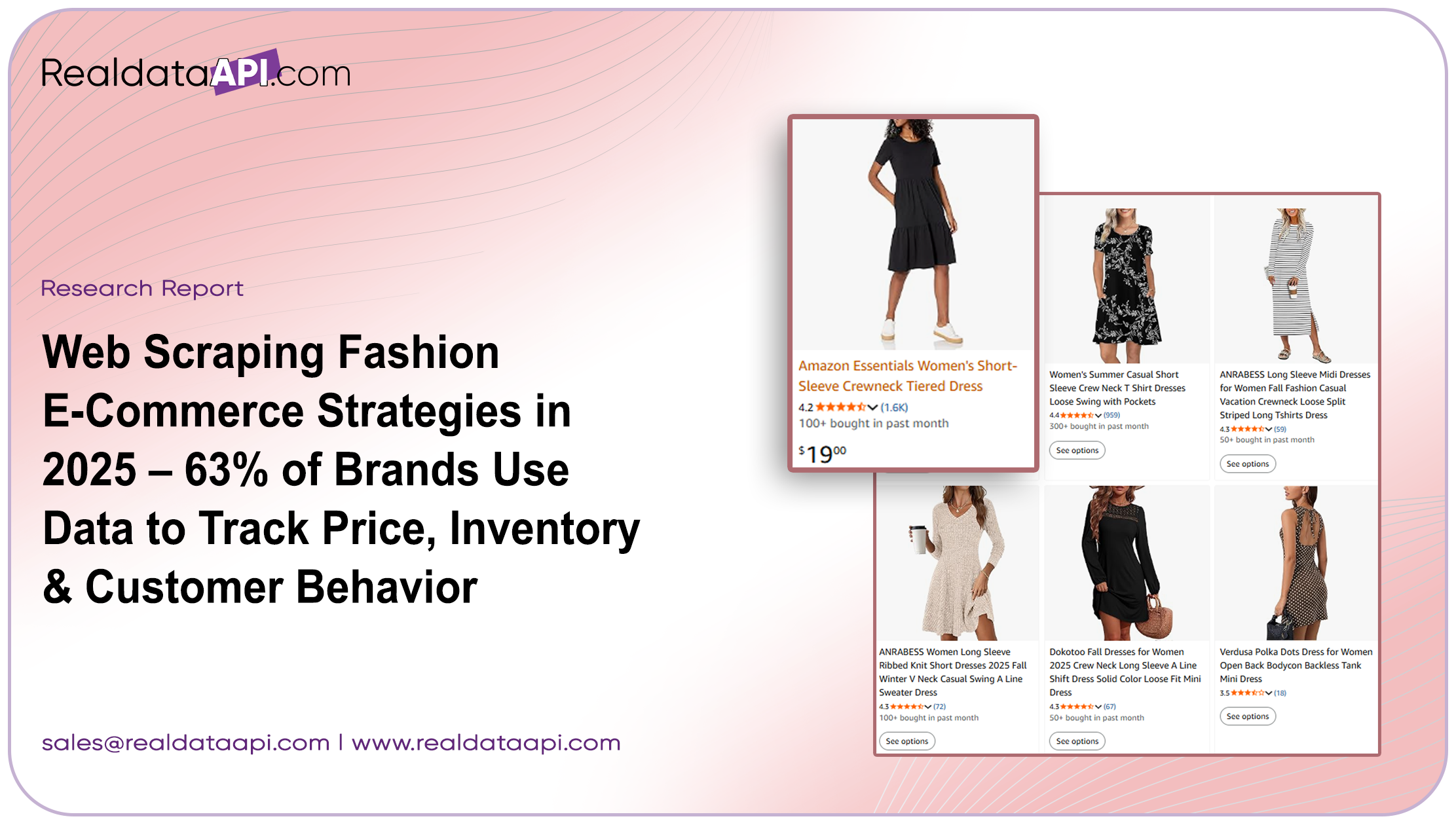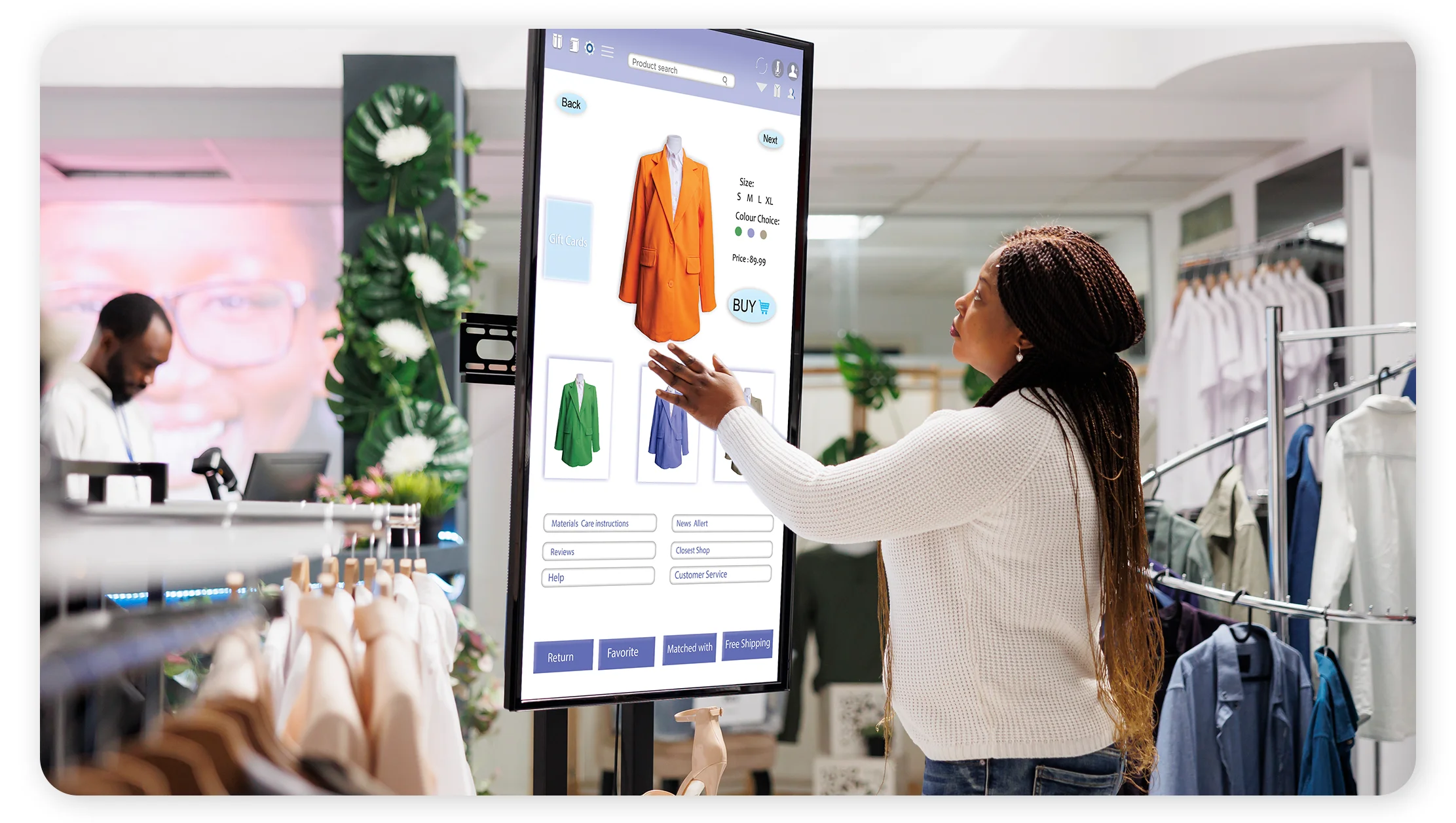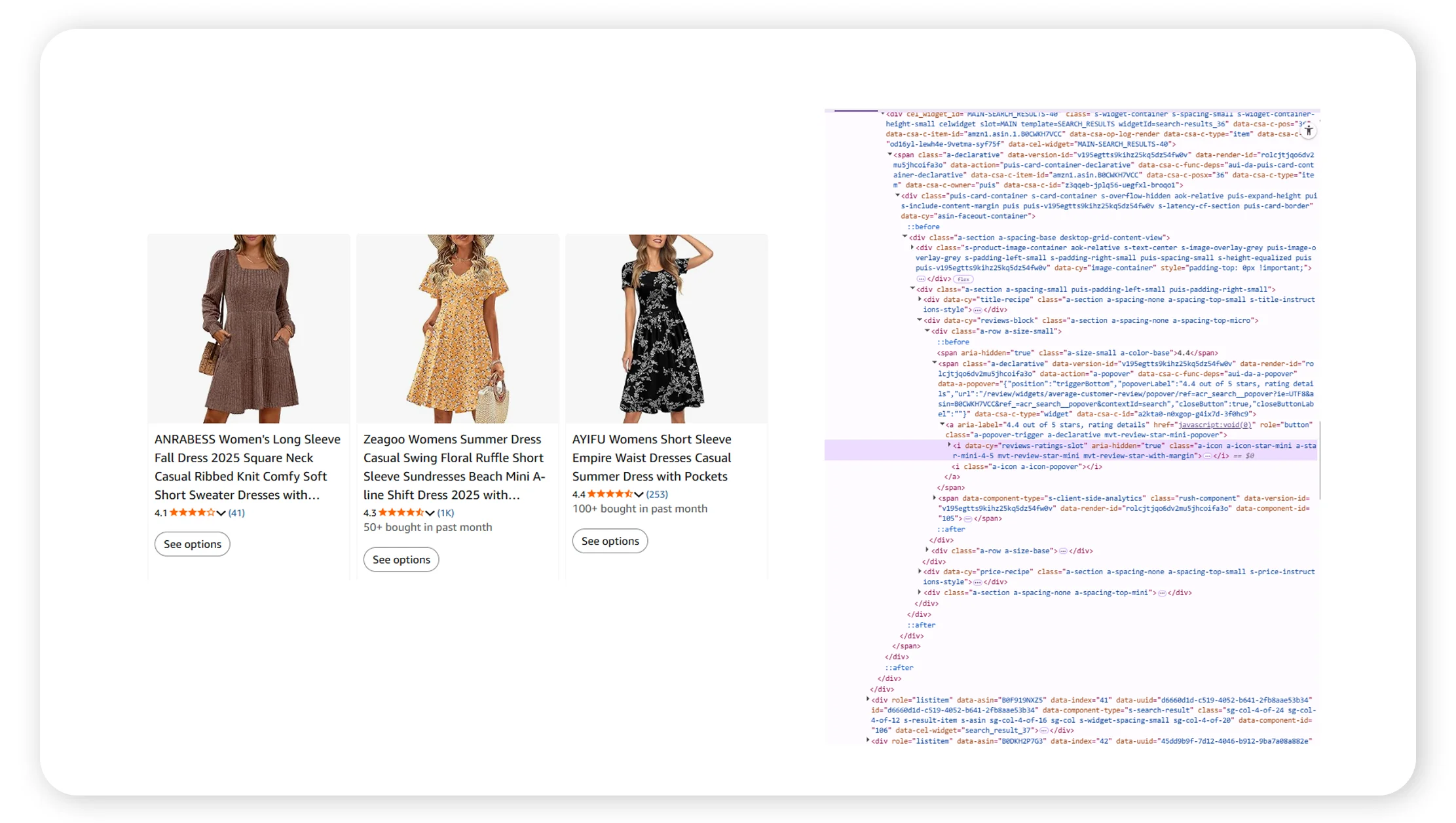

Introduction
The fashion e-commerce landscape in 2025 is rapidly evolving, with brands increasingly relying on data to inform strategic decisions. Web Scraping fashion e-commerce strategies in 2025 are helping companies gain actionable insights into pricing, inventory, and customer behavior. With the rise of Fashion & Apparel Datasets, retailers can now analyze vast amounts of product information and consumer trends efficiently. Tools that enable real-time monitoring allow brands to respond faster to market shifts, optimize product assortments, and improve competitive positioning. By combining analytics with automated data collection, businesses are better equipped to anticipate demand and tailor the shopping experience. The adoption of data-driven approaches is no longer optional; it has become a necessity for companies that want to remain agile and profitable in the dynamic online fashion market.
Fashion Retail Trends 2025

The fashion retail industry in 2025 is witnessing significant transformations, driven by technological advancements and changing consumer behaviors. Brands are increasingly adopting Web Scraping fashion e-commerce strategies in 2025 to stay competitive in this dynamic landscape. By leveraging data-driven insights, retailers can monitor competitor pricing, track inventory levels, and analyze customer preferences in real-time. This approach enables businesses to make informed decisions, optimize their product offerings, and enhance customer satisfaction.
The integration of artificial intelligence and machine learning algorithms further enhances the accuracy and efficiency of these strategies, allowing for predictive analytics and personalized recommendations. As a result, fashion retailers are better equipped to anticipate market trends, respond to consumer demands, and maintain a competitive edge in the evolving e-commerce environment.
Moreover, the rise of social commerce and influencer marketing has reshaped how brands engage with consumers. Platforms like TikTok and Instagram have become integral to fashion marketing strategies, enabling brands to reach a broader audience and drive sales through engaging content and collaborations with influencers. This shift emphasizes the importance of a strong online presence and the need for brands to adapt to the digital landscape to remain relevant.
In conclusion, the fashion retail trends in 2025 highlight the industry's shift towards data-driven decision-making, technological integration, and digital engagement. Brands that embrace these changes and leverage innovative strategies will be well-positioned to succeed in the competitive fashion e-commerce market.
Data Trends in Online Fashion Retail

The proliferation of digital platforms has led to an explosion of data in the online fashion retail sector. Retailers are harnessing this wealth of information through Web Scraping fashion e-commerce strategies in 2025 to gain actionable insights into consumer behavior, market trends, and operational efficiencies. By analyzing data from various sources, including social media, e-commerce websites, and customer reviews, brands can identify emerging fashion trends, assess product performance, and tailor their marketing strategies accordingly.
This data-driven approach not only enhances decision-making but also fosters a deeper understanding of customer preferences, enabling retailers to deliver personalized shopping experiences. Furthermore, the use of advanced analytics tools allows for the segmentation of customer data, facilitating targeted promotions and inventory management. As the volume of data continues to grow, the ability to effectively analyze and utilize this information becomes increasingly crucial for success in the online fashion retail industry.
The integration of artificial intelligence and machine learning algorithms has further amplified the potential of data analytics in fashion retail. These technologies enable retailers to predict consumer behavior, optimize pricing strategies, and enhance supply chain management. By leveraging AI-driven insights, brands can stay ahead of market trends and make proactive decisions to meet consumer demands.
In summary, the data trends in online fashion retail underscore the importance of leveraging data analytics to drive business growth and enhance customer satisfaction. Retailers that effectively utilize data-driven strategies will be better equipped to navigate the complexities of the digital marketplace and achieve sustained success.
Real-Time Inventory and Pricing Data for Fashion Retailers

In the fast-paced world of fashion retail, staying updated with real-time inventory and pricing information is essential for maintaining competitiveness. Web Scraping fashion e-commerce strategies in 2025 enable retailers to monitor stock levels, track price fluctuations, and adjust their offerings accordingly. This real-time data allows businesses to respond swiftly to changes in consumer demand, optimize pricing strategies, and prevent stockouts or overstock situations.
By integrating real-time data into their operations, fashion retailers can enhance supply chain efficiency, reduce operational costs, and improve customer satisfaction. Moreover, the ability to monitor competitor pricing in real-time provides valuable insights for strategic decision-making, allowing brands to remain agile and responsive in a competitive market.
The adoption of real-time data analytics is becoming increasingly important for fashion retailers aiming to thrive in the digital age. By leveraging advanced technologies such as Internet of Things (IoT) devices and cloud-based platforms, retailers can gain real-time visibility into their inventory and pricing data, enabling them to make informed decisions and maintain a competitive edge.
In conclusion, the integration of real-time inventory and pricing data is crucial for fashion retailers seeking to optimize their operations and meet the demands of today's consumers. By embracing these technologies, brands can enhance their responsiveness, improve operational efficiency, and achieve sustained success in the dynamic fashion retail landscape.
Analyzing Customer Behavior in Online Fashion Shopping 2025

Understanding customer behavior is paramount for success in online fashion retail. In 2025, retailers are leveraging Web Scraping fashion e-commerce strategies in 2025 to gain deeper insights into consumer preferences, browsing habits, and purchasing patterns. By analyzing data from various touchpoints, including website interactions, social media engagement, and customer reviews, brands can identify factors influencing buying decisions and tailor their offerings accordingly.
This data-driven approach enables retailers to deliver personalized shopping experiences, optimize product recommendations, and enhance customer loyalty. Furthermore, understanding customer behavior allows businesses to anticipate market trends, adjust marketing strategies, and improve inventory management.
As consumer expectations continue to evolve, the ability to analyze and respond to customer behavior is becoming increasingly crucial for fashion retailers aiming to stay competitive in the digital marketplace. By leveraging advanced analytics tools and technologies, brands can gain a comprehensive understanding of their customers and make informed decisions to meet their needs.
In summary, analyzing customer behavior is essential for fashion retailers seeking to enhance customer satisfaction and drive business growth. By adopting data-driven strategies and technologies, brands can stay ahead of market trends and deliver personalized experiences that resonate with their target audience.
Scrape Fashion Products API for Competitive Analysis

Competitive analysis is a critical component of strategic planning in the fashion retail industry. The Scrape Fashion Products API for Competitive Analysis provides retailers with the tools to extract and analyze product data from various e-commerce platforms. By utilizing this API, brands can monitor competitor product offerings, assess pricing strategies, and identify market gaps.
This information enables businesses to make informed decisions regarding product development, pricing, and marketing strategies. Additionally, the API facilitates the tracking of product performance metrics, such as sales volume and customer reviews, providing valuable insights into consumer preferences and market trends.
By integrating the Scrape Fashion Products API into their operations, retailers can enhance their competitive intelligence, optimize their product assortments, and improve overall business performance. This integration allows for automated data collection and analysis, reducing manual workloads and improving decision-making processes.
In conclusion, the Scrape Fashion Products API serves as a valuable tool for fashion retailers seeking to gain a competitive edge in the market. By leveraging this technology, brands can enhance their strategic planning, improve operational efficiency, and achieve sustained success in the dynamic fashion retail landscape.
Web Scraping API
The Web Scraping API serves as a powerful tool for fashion retailers seeking to automate data collection and analysis processes. This API allows businesses to extract structured data from various e-commerce websites, enabling the monitoring of product listings, pricing, and inventory levels.
By automating these processes, retailers can reduce manual labor, increase data accuracy, and enhance operational efficiency. The Web Scraping API also supports scalability, allowing businesses to collect data from multiple sources simultaneously and in real-time. This capability is particularly beneficial for fashion retailers operating in dynamic markets, where timely access to accurate data is essential for making informed decisions.
Furthermore, the API's flexibility allows for customization to meet specific business needs, making it a valuable asset for fashion retailers aiming to leverage data for competitive advantage. By integrating the Web Scraping API into their operations, brands can enhance their data collection capabilities, improve decision-making processes, and maintain a competitive edge in the fashion retail industry.
In conclusion, the Web Scraping API is an essential tool for fashion retailers seeking to harness the power of data in their operations. By adopting this technology, brands can streamline their data collection processes, improve operational efficiency, and achieve sustained success in the competitive fashion retail market.
Real Data API provides fashion retailers with reliable, up-to-date datasets to optimize pricing, inventory, and marketing strategies. Its Fashion & Apparel Datasets enable brands to gain competitive insights efficiently. With features like Scrape Fashion Products API for Competitive Analysis and Web Scraping API, businesses can automate data collection, monitor competitors, and personalize customer experiences. Real Data API ensures compliance with data privacy standards, allowing companies to leverage insights responsibly. This empowers retailers to make informed decisions, improve operational efficiency, and maintain a competitive edge in a fast-paced market.
Conclusion
In 2025, data-driven approaches are essential for success in fashion e-commerce. Web Scraping fashion e-commerce strategies in 2025 allow brands to monitor prices, inventory, and customer behavior in real time. Tools like Scrape Fashion Products API for Competitive Analysis and robust datasets support decision-making, trend forecasting, and dynamic pricing. Businesses using these technologies can anticipate market shifts, optimize their product offerings, and enhance customer satisfaction. Adopting intelligent data solutions is no longer optional—it is critical for staying competitive, driving growth, and maintaining leadership in the evolving fashion retail sector.Explore Real Data API to unlock actionable insights for your business today!













